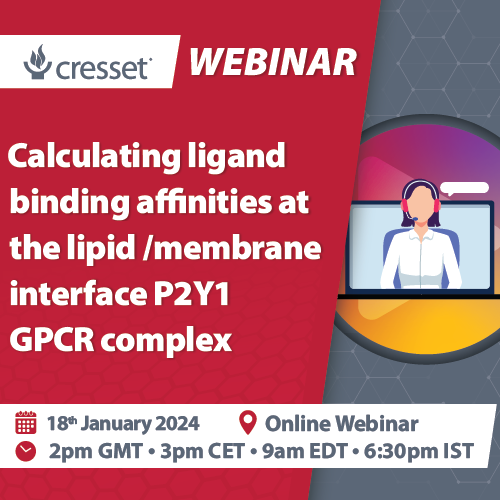Register here - Calculating ligand binding affinities at the lipid /membrane interface P2Y1 GPCR complex (cresset-group.com)
G protein-coupled receptors (GPCRs) are a very large and important class of drug targets. They are also a very difficult class in terms of modeling with adequate accuracy the necessarily many atoms that constitute the protein, ligands, membrane lipids and solvent. Faster and more accurate computational solutions are required for these challenging systems. In this session we discuss a workflow using computational chemistry methods that are available within Cresset’s CADD software platform, Flare™ to arrive at accurate binding free energies for a set of P2Y1 ligands bound to a lipid-exposed binding site.
The methods are:
- Molecular Dynamics (MD)
- Water analysis solving the Ornstein-Zernike equation (3D-RISM)
- Alignment of ligands for FEP (Conf Hunt & Align)
- Relative binding free-energy (RBFE) perturbation theory (Flare FEP).
We show that using MD, water analysis and careful ligand alignment prior to RBFE calculations can result in reliable predictions for protein-ligand binding affinities even in the case where the ligand is at the lipid-protein interface. Until recently the computational cost of such a large system (93,255 atoms) would be prohibitively large. Implementing methods that ensure a stable and appropriately hydrated binding site (a suitable snapshot of in vivo binding action) as input to the RBFE calculation results in an efficient process for setting up the RBFE job to yield accurate results. The RBFE calculation itself is improved, in terms of efficiency, by the implementation of adaptive Lambda (λ) schedules and automated intermediate generation. The results that will be presented show that the predicted binding free energy of 30 ligands matches the measured experimental affinity closely (mean unsigned error is 1.17 kcal/mol). This difficult computational problem can now be solved relatively quickly with good accuracy by using these methods, and, in principle this workflow could be extended to further membrane protein targets in drug discovery.
About the presenter
Dr Jennifer Brookes has over 15 years of scientific research experience and background in theoretical and computational chemistry and biophysics. Her scientific contributions have ranged from exploring the possibility of quantum effects in olfaction, quantifying efficient energy transfer processes inphotosynthesis to exploiting protein-protein interactions in antibody (nanobody)- antigen pairs. Jennifer’s research has taken her from King’s College London to University College London, MIT, Harvard and most recently back to University College London at the London Centre for Nanotechnology as lead computational and theoretical biophysicist in the £11M EPSRC IRC for Early Warning Sensing Systems for Infectious Disease. As an FEP Application Scientist at Cresset Jennifer’s responsibilities include supporting customers to use Free Energy Perturbation calculations for reliable and accurate predictions of ligand binding free energies that will inform and guide their drug discovery projects.
Register here - Calculating ligand binding affinities at the lipid /membrane interface P2Y1 GPCR complex (cresset-group.com)


